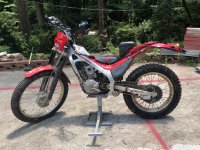Josh K.
100 W
 Hi Folks, Very interesting thread.
Hi Folks, Very interesting thread. I am a fan of the idea of using a clutch on the light electric motorcycles. I recently went to Moab Utah, and rode the slick rock
trail again, but with a 350cc motorcycle instead of a traditional pedal mountain bike. One interesting thing of course is to see
the E bikes being used out there too. I saw a pair of Segways, and can imagine the Sir Ron crowd totally digging the miles of skate
board park like area to ride.
But, what I learned is that the motorcycle guys are using the clutch to offer some slip, when climbing. When we have about 40 hp, and the throttle is at about 1/3rd, you can climb walls out there. The traction is amazing, especially when tire pressure is down
at around 14 lbs. But, sometimes we just did not have enough hp to keep it going up the hill, and if one were to add throttle, the front wheel would come up, and scare you. So we learned to feather the clutch up top, and it smoothed out the climb. It was nothing short of amazing. I loved it.
I kind of think of it as a slipping gear reduction, that gave us more control. I feel that it could also be very useful in ramping up
the torque, as we transition from very flat, to very steep, and need to launch up onto the hill climb. Which brings me to hill climbs.
I think that really steep, big hill climbs could be really fun for the big boy motors, where we could really let them run, full tilt.
I used to run an E tek, at 50 volts, and with a 500 amp controller. But could never get the traction right for a full launch. We would leave 80 feet of rubber, before hooking up completely, or would spin the rim in the tire...But, I would love to build up an old school dirt bike with and extended rear triangle, for hill climbing. And, I bet it would be advantageous to be able to feather the slip, when digging up a monster hill. Something that would empower the rider to be able to modulate the power a little more.
Additionally, It is my belief that the full on road motorcycles are going to grow up, and use a 6 speed with a clutch as well. I was one of the first to buy a Zero MX motorcycle, back in 2008. And it was a great minibike. Yeah, I said it, minibike. Fun for around mom's house type of thing, for the teens. It did not have awesome take off, or top end. Sure, it was really fun from 15 mph to 45 mph, where it was in it's sweet spot. But it totally could have used at least a two speed, with a clutch to dump the power hard, and to really throw rocks. People love the electric motor, and it's raw power on take off, but we could have more, where we let the motor spin up a little bit, then dump both the clutch and the throttle for the best power, ideally in a lower gear, then up through the range, for ultimate speed.
I run a 1,500 watt mid drive through my bicycle drive train, and love to use all of my gears. Sweet hill climbing, super efficient when I want to be, and nice high end for passing roadies. Sure, I use a 9 speed, but that is because it's easily obtainable in the bicycle world. My new bike is using an 8 speed internal hub, with a 1,500 watt Astro flight build. And, I can say that after 10 years of using this system, if I were to be building up a motorcycle, I would totally want a 6 speed or so, with a clutch, to blast the power through the system.
Soo, I am tinkering with the idea of building up a trials like motorcycle, to ride in Moab, with an E tek and am looking for a gearbox clutch combo to set up between my motor, and rear wheel. Ideas? Thanks so much, Josh K.


